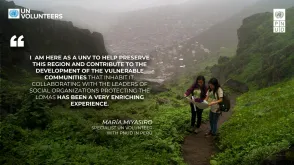María Miyasiro is a UN Volunteer serving in Peru with the United Nations Development Programme (UNDP) as a specialist in geographic information systems and remote sensing within the EbA (Ecosystem-based Adaptation) Lomas project. In celebration of International Day for Biological Diversity, María shares her experience of protecting a unique ecosystem on a digital and volunteer basis.
"I started to get involved in the study and conservation of the Lomas because of my thesis. However, if I have been at it for four years, it is due to the people and organizations with whom I collaborate. United, we are achieving goals that, until recently, seemed too far away," María states soon after our interview begins.
The Lomas (Spanish for hills) are ecosystems with singular ecological conditions originated by the dense winter fog in the surroundings of the Peruvian capital, an environment of great biological and geological value. “For a city like Lima – the second-largest city settled on a desert with ten million inhabitants and few green spaces – having such areas is a great opportunity to reduce the impact of climate change and contribute to more resilient and sustainable communities,” María explains.
She also tells how, unfortunately, most citizens are unaware of the value of these green treasures and their impact on conserving the environment. The Lomas’ existence is thus threatened by land traffickers and the indifference of those who should protect them.
María, a geographical engineer from the National University of San Marcos, wrote her thesis driven by her passion for this unique ecosystem in her city; however, her efforts didn't stop there.
In Lima, funded by the Global Environment Fund (GEF), UNDP and the Peruvian National Service of Protected Natural Areas (SERNANP) have been working collaboratively to protect and manage the Lomas areas in a sustainable way; and this was the perfect opportunity for her to work directly on the issue.
"I am here as a UN Volunteer to help preserve this region and contribute to the development of the vulnerable communities that inhabit it. Collaborating with the leaders of social organizations protecting the Lomas has been a very enriching experience. Seeing their daily struggle, learning from their experiences and their vision of the territory is my main inspiration to give my best," she shares with a smile.
María says: “Four UN Volunteers have been serving at EbA Lomas since 2017, and right now two of us continue: Jorge Ricaldi, a specialist in fog water capture, and myself. I perform various tasks within the team; I am currently working on collecting information using drones, satellite images, aerial photographs and fieldwork, and also carrying out different activities, such as workshops, together with public institutions, municipalities, and social organizations."
María also highlights her coordination role between the Ministry of Culture or the Peruvian Geological, Mining and Metallurgical Institute (INGEMMET, in Spanish) and local administrations, tasks in which she is in charge of offering technical assistance. In addition to this, she took part in the elaboration of the documentation for Lima’s first Regional Conservation Area (ACR, in Spanish), the Sistema de Lomas de Lima ACR, established in December 2019. “The natural value of this ecosystem is the initial origin of these projects, but the Lomas is also relevant from a geological and cultural point of view,” María declares.
Among the several initiatives that she has been working on, María mentions the Lomas de Lima Geoportal and the Geolomas viewer. These are mapping tools responding to the specific needs of the defenders of the Lomas and local officials in charge of this area.
“They often lack material resources and specialized personnel, and they need to know the spatial dimension of the territory where they are working and the uses that are given to the land, as well as to locate areas of interest and potential incidents,” María shares. "The data we have been collecting is extremely useful for all of this, and through the development of simple visual and interactive tools we can facilitate their work enormously."
To extend the use of these tools and promote specialized training about the geographical and legal circumstances of the Lomas among the neighbors and those who work in the field, Maria's team has conducted many workshops during this time.
"Due to the impact of the pandemic, we had to put face-to-face activities on hold in March 2020," María says. "Therefore, online communication became essential, and I took care of recording and video editing the workshops so that they were available to anyone." She points out too how important it is in such an extraordinary situation to have different profiles in the team, as well as to rely on local volunteer structures and neighborhood collaboration.
María is clear that volunteering is key to face the challenges of the region: “I loved the meetings with UN Volunteers serving with other agencies, thanks to which I was able to learn about different projects, such as social initiatives. Not long ago, a UN Volunteer with the same assignment but in Pakistan, who had recently started in their role, contacted me seeking advice."
I believe that at a global level, the exchange of experiences and points of view can be very positive; it does not have to be only national. Thanks to UNV and the perspectives shared by volunteers and other UN agencies.”
This article was prepared with the kind support of Online Volunteer José María Sainz Maza del Olmo.

